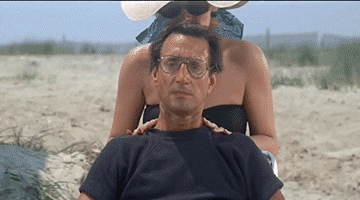Perspective Distortion
A great example of perspective distortion can be seen in stop motion animator Micaël Reynaud's animated GIF below.
(C) Micaël Reynaud
This is an example of a cinematography technique called the Dolly/Hitchcock zoom (as seen in Vertigo and Jaws) but the principle is the same; perspective distortion is used as effect where the frame/image shows the same subject occupying the same size/portion of the frame and the perspective changes by going from a wide to telephoto field of view.

(C) 1975 Universal Pictures, "Jaws" - reverse dolly zoom
The interesting areas to note are the extension and compression of the background elements, in which the wide angle shots pushes (extension) the buildings further away and the telephoto shots pulls (compression) the buildings forward making them appear much larger and closer than in real life. It should be obvious that the photographer has not moved either the subject (the huge, heavy concrete block) nor the buildings in the background.
Perspective and Headshots
So why does this matter for a headshot in which we roughly mean from the top of subject head to top of the shoulders? Note that this discussion is limited to headshot (as described) and not portrait: the answer is related to perspective distortion.There is a great article by Stephen Eastwood that shows what can happen if we choose to make a classic headshot with various focal lengths. The important thing to note is that whilst there is no issues with creating portraits with wide angle lenses, there are technical reasons why you may wish to create headshots with longer focal lengths such as the medium telephotos 85mm/105mm/135mm (or even longer) on 35mm/FX. The medium telephotos on 35mm/FX are typically described as the 'classic' or recommended headshot focal lengths. But why is that? It again comes down to perspective distortion. Remember that the longer lens will compress an image more than a wider lens and it's really the subtle compression of the facial features that matter - in this case the nose-eyes-ears.
But note that whilst we talk about 85mm-135mm focal lengths it's also the field of view (for 35mm/FX this is between 28 and 18 degrees) that care about since this will also determine the distance required between the camera and subject to fill the frame for a headshot. This is compared to the 50mm FOV of 46 (or 31 on DX) degrees and 70mm FOV of 35 (or 22 on DX) degrees where you can see we would require to be closer to the subject to fill the same frame and thus introducing the distortion.
A headshot with a wide (anything below 35mm) or even normal (50mm) lens will distort and pull the nose/chin/forehead (it's the closest thing to the camera) forward whilst pushing the ears/hairline back which will create a cartoonish caricature. Starting with the medium telephotos we start to see a subtle but more 'normal' or 'real life' depiction of the subject being captured whilst the longer (200mm and up) may introduce too much facial compression.
Consider the headshots below, shot on FX from 50m/85mm/105mm/135mm and 200mm. Note the apparent distances between the nose, eyes and ears.

Nikon FX body with lenses: 50mm f/1.8G, 70-200mm f/2.8G (version I)
The indoors/studio choice between 85mm vs 105mm vs 135mm tends to be personal choice that may be determined by personal preference on level of compression but also shooting distance available. When shooting outdoors where (lack of) studio space is not an obstacle, the choice for longer focal length for headshot may be dictated by the field of view or level of background compression required.
Between the focal lengths of 70mm/85mm/105mm available to me, I personally prefer the 85mm partly because of the compression (over the 70mm) and working distance (over the 105mm) but a lot of my choice is also influenced by the sharper optics and wider available apertures (an 85mm f/1.4 vs 70mm f/2.8 or manual focus 105mm f/2.5).
Again, a headshot or portrait can be taken with any focal length but the discussion here should give you a few considerations for why the classic headshot focal lengths exist.
No comments:
Post a Comment